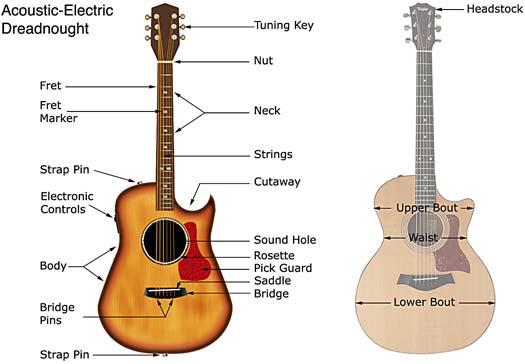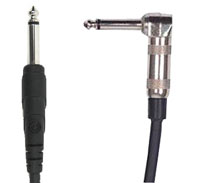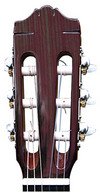Guitar Glossary
An Illustrated Guide of Parts and Terms
One of the most important reference guides for new players is an illustrated guitar glossary.
Guitarists, like all others who learn a specialty, create and use a specialized language. Learning this 'lingo' could take you months or years... if you did it the old-fashioned way.
But, you're not all that old fashioned, are you? You know there is a better way to learn the names of all those guitar parts, music notations, equipment pieces. You know to...
...bookmark this guitar glossary! ...and refer back to quickly look up any term you need to know, at any time!
As with most glossary's, this one is likely to grow and change over time. Still, if you don't find a term, or if an explanation is unclear, please Contact Me.
For new players, I recommend that you start by reviewing the illustration below. Then browse the guitar glossary terms that follow. If you know the term you are looking for, use the quick alphabetic index to jump to the first letter of that term.
 |
Glossary Jump Letters
Click on any letter to jump to that location in the Glossary.
A B C D E F G H I J K L M N O P Q R S T U V W X Y Z
A
Acoustic GuitarA guitar that uses air, vibrating strings, and body shape to produce sound.
Action
The height between the strings and the fretboard is frequently referred to as the 'action'. A high-action means that your strings are relatively far from the fretboard, requiring stronger fingers, more force, and more time to sound a note. A low-action means that your strings are as close as possible without causing undesirable buzzing. For more information see my explanation that discusses the key differences between acoustic and electric guitars.
Active Device (Output/Pickups/Electronics)
If your guitar (or microphone) uses electricity (such as batteries) then it is an active device. Be certain to use active-capable devices with it.
Amplifier
A device that converts electrical impulses back to their original sound, at elevated volume.
B
Back FilingIf you inspect the saddle (the ivory color bar supporting the strings) on an acoustic guitar, you might notice a small section that is raised slightly, and filed so that the B-string contacts it differently than the other strings. This is segment is 'back-filed', and this is an example of back-filing.
The saddle is filed differently for the B string to account for intonation characteristics that differ from each of the other strings. Without this back-filing, you would be unable to keep the B-string in tune up and down the fretboard.
Binding
Binding is either a term that descibes a string that sticks in the nut, or the decorative trim around wood joints.
With respect to a string that is 'binding' in the nut, this can happen when you put new strings on your guitar that are a thicker guage than the originals, or if the nut was not correctly notched. Regardless of the reason, the string will not slide properly, resulting in sudden pops and difficulty tuning.
The term also describes the decorative trim around wood joints on the guitar, especially where the sides of the body join the top and back. Binding is typically white, ivory, black, or brown. It adds a decorative touch and helps hide seams.
Bridge
On a guitar, a strengthened portion of the body, where the strings are attached and the saddle is held firmly.
In a song, a transition to connect the beginning verses and chorus to the big finish. For more, see the easy song Away In A Manger.
Bridge PinSome guitars are equipped with Bridge Pins. These slotted plugs help hold guitar strings in place on some instruments.
C
Chord
A combination of notes played simultaneously. See also Major Chord, Minor Chord, Augmented Chord, and Diminished Chord.
Chorus
The lyrics & melody portion of a song that contain the core message. The chorus is typically repeated after each verse. For more, see the easy song Away In A Manger.
Cutaway
The rounded indentation where the neck and body join together, providing easy access to the upper frets, is called the cutaway.
D
E
Electric Guitar
A guitar that produces sound by amplifying the vibrating strings using electronics. The electronics require some type of amplifier and speaker for an audience to hear the sound.
F
Feedback
Feedback is created by amplified sound re-entering the amplification system. The key components are an amplifier and a microphone. The problem begins when sound enters the microphone and is amplified. The amplified sound is then picked up by the microphone and is amplified again. This creates a feedback look in which the sound is repeatedly amplified. Eventually it reaches a point where it oscillates to create aloud pulsing noise or a high-pitched squeel.
Easy tips to prevent feedback: Take care when placing microphones and speakers. Point your speakers so the sound is not directed toward microphones. Use omnidirectional microphones to minimize the potential for amplified sound reentering the system. Turn down the gain on the microphone.
Fret
A strip of metal, placed on the fretboard to mark the location of notes for the guitar strings.
Fret Marker
Any marking on the fretboard to assist the guitarist to quickly locate a particular fret. Fret markers are typically found at frets 3, 5, 7, 9, 12, 15, and 17. Fret twelve is usually marked differently, to indicate the octave fret. Many guitars have small fret markers on the side of the neck, for easy reference as you look down while playing.
G
Guitar Strings
Strings for electric and steel string acoustic guitars are very similar, but cannot be used interchangeably. Each consists of a steel hexagonal wire wrapped by another wire. The type of wire used for the wrap affects the sound characteristics. Nickel is the most popular, and gives a good overall sound. Stainless Steel produces a tone considered brighter than most. Phosphor Bronze are less bright than nickel. Brass tends to provide a bright, loud sound. Tin coatings are sometimes used.
For more information see my page on Guitar Strings.
H
Harmonic Tones
It's math... but there are certain places along a guitar string where you can produce multiple tones. These locations happen to be located directly above the fret wires at the 5th, 7th, and 12th frets. It works because at these specific points the string will continue to vibrate in two independent sections, when you apply pressure at the harmonic point. Using harmonics for tuning works well because you are not bending the string in any way. If you haven't played a harmonic before, try this: Pluck any string. Now lightly touch that string just above the 12th fret wire. If you press down just right, you will hear the harmonic tone. If you press too hard you will either mute the string or hear the octave note.
Humbucker
A type of electric guitar pickup, designed to cancel out magnetic and electronic noise.
I
Intonation
The ability of your instrument to play and hold the correct note.
Intro
Intro, short for "Introduction", is the passage of the song leading up to the first verse. Typically an intro consists of either four or eight bars of the chorus. An intro is often the same passage as the Outro. For more, see the article on the easy song Away In A Manger.
In Tune
A note is in-tune when it matches the pitch of another note in the manner it is supposed to. When tuning a guitar, strings are "in tune" with each other when you can sound the same note on different strings and they sound the same. When playing a chord, a note is in tune if it sounds at the right interval from the other notes around it.
J
K
L
Luthier
A craftsman who builds guitars.
M
Major Chord
The combination of the first, third and fifth notes of a scale.
N
Neck
Extending from the guitar, the neck contains frets and fret markers that identify where to press on a given string to produce a particular note.
Note
A note is defined by it's frequency: the speed of vibration of the sound producing device. For a guitar, the vibration is created by the strings.
Nut
A rigid slotted bar used to separate and raise the strings at the uppermost end of the fretboard. At the other end is the saddle. Together the saddle and the nut keep the string elevated off of the fretboard, allowing them to vibrate freely, creating sustained notes.
O
OctaveA simplified definition is: eight notes in sequence. Technically, this definition is only true if you think of notes by their name. For example, the notes C-D-E-F-G-A-B-C form an octave from C to C.
More specifically, an octave is any two tones with frequency ratios of either 2-to-1 or 1-to-2.
You can easily identify one octave in music notation: anytime you see a two notes with the same letter-name, at different locations, they are one or more octaves apart. You can easily identify one octave on a piano keyboard by counting up or down to the 13th key (you must count the first key). On a guitar the easiest way to illustrate an octave is with the twelfth fret, which is one octave above the note for that same string when it's played open.
Outro
The ending passage of a song, typically made up from four or eight bars of the chorus. An outro is often the same passage as the Intro. For more, see the article on the easy song Away In A Manger.
Out of Tune
While I hate putting it this way, the fact is that anything not "in tune" is, by definition "out of tune." So, see the definition for in-tune.
P
Passive Device (Output/Pickups/Electronics)
If your guitar (or microphone) does not use electricity (including batteries) then it is a passive device. Be certain to use passive-capable devices with it.
Phono Plug (or Phone Plug)
 To move the sound signal from your guitar to an amplifier or other audio device, you plug one end of a cable into your guitar, and the other end of the cable into the amplifier or audio device. The plug on the end of the cable is called a phono plug, or phone plug (see the image to the right).
To move the sound signal from your guitar to an amplifier or other audio device, you plug one end of a cable into your guitar, and the other end of the cable into the amplifier or audio device. The plug on the end of the cable is called a phono plug, or phone plug (see the image to the right).
Phono plugs are generally 1/4" in diameter. Hence, you will frequently read about cables with 1/4" phono plugs. These plugs can be either straight, or shaped into a right angle.
Some guitars, such as a Fender Stratocaster, will accept only straight-end cables. Many guitars, especially guitars with audio-out jacks on the side of the instrument, work best with right-angle plugs. A key benefit of using a right-angle plug, if your guitar will accept one, is the reduced length of the cable as it extends from your guitar. Why is this important? A longer extension means you are more likely to strike objects with the plug or cable, possibly causing damage.
Pick Guard
Typically made of plastic, this colorful overlay protects the body finish from damage caused by a pick or fingernail. Oddly, there is never a pick guard above the sound hole.
The frequency generated by a vibrating string. For example, the frequency of the Concert-A note is 440Hz.
Q
R
Relative Pitch
The comparison of one pitch to another. 'Relative pitch' often refers to tuning a string so that it matches the pitch of another string. Tuning this way, rather than to an absolutely correct frequency, can make that are slightly out of tune sound correctly tuned.
Root
The first note of a scale. A chord is named for it's root, even if the root is not actually played.
Rosette
A decorative pattern around the sound hole. It is purely decorative.
S
SaddleThe rigid bar at the opposite end of the strings from the nut. The saddle is located near the base of the guitar, imbedded in the bridge. The nut and the saddle work together to keep strings off the fretboard, so they can vibrate and produce sound. On an acoustic guitar, the saddle is frequently an ivory color. See also Back-Filing.
Six String
Shorthand for a guitar that has six strings. Most acoustic and electric guitars have six strings, some have twelve.
Sound Hole
The opening in the body of an acoustic guitar, nearly always round, that allows sound to escape. Without this, an acoustic guitar would sound muffled.
 |
Slotted Headstock
A decorative Headstock style.
Standard Tuning
A six-string guitar tuned to E-A-D-G-B-E, or a bass tuned to E-A-D-G. Most beginners learn in standard tuning.
Strap Pin
A secure button for attaching a guitar strap. These are almost always metal.
Sustain
The duration of sound from one or more strings. The longer a note, or notes, can be heard, the longer the sustain.
T
Tone
The combination of pitch, volume, sustain and sound character produced by a particular guitar or guitar equipment.
Truss Rod
A rigid bar inside the neck of a guitar. Turning the Truss Rod adjusts the bend in the neck, which increases or decreases the distance between the strings and the fretboard.
Tube (Valve)
"Tube" is the U.S.A. slang term for "electron tube". Tubes are glass enclosed devices that modify and/or amplify input signals to produce loudspeaker sound.
See also the
Amplifier Tubes Explained page.
Tuning
Adjusting the tuning keys until a particular string vibrates at the correct frequency, and sounds the proper note(s).
Tuning Key
A knob used to tighten or loosen a string. The effect is to raise or lower the pitch to bring the string into proper tune.
U
V
Verse
The lyrics " melody portion of a song that tell the flowing story. A chorus is usually song after each verse. For more, see the easy song Away In A Manger.
W
X
Y


